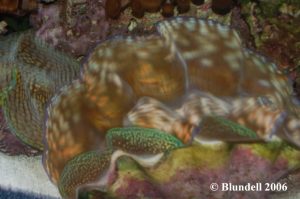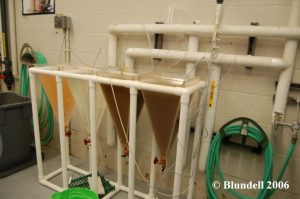Marine invertebrates serve an important role in the captive reef and in therefore in the marine ornamental industry. During the late 1990’s an appreciation and desire for invertebrates flourished in the aquarium trade. Stemming from this interest several books have been written for hobbyists which directly address invertebrates (Sprung , 2001; Calfo & Fenner, 2003; Shimek 2004). It should also be noted that those books most certainly increased the interest and respect for marine creatures. Those authors should be credited for greatly advancing the hobby. The current stage and trends in the hobby lead us to believe that invertebrates will serve a bigger role and will become ever more popular during the next decade.
Larval Systems
Larval rearing systems can be designed and used for many animal species. Historically they have been used in the marine trade for delicate fishes. With the current growth, and expected growth, of marine invertebrates in captive aquaria there is a need to look at these systems from a new perspective. The rearing of crabs, shrimp, lobster, seastars, urchins, may be around the corner.

Feeding larval invertebrates is often challenging. One of the keys for many aquaculture projects has been to use large scale growing systems for live micro plankton.
Invertebrate systems have recently focused on shrimps (not necessarily true shrimps) for two primary reasons. One, they are important in the aquatic trade; Two, they are have shown signs of success.
What to raise?
Well that is the million dollar question. One side of the coin says raise something you know can be raised, and the other side of the coin says you might as well try something new. Today, a quick internet search will show dozens of people who have successfully raised a variety of peppermint shrimp. While at the same time only one person has raised fire shrimp and no one has raised banded coral shrimp. Rest assured any effort you put into raising ornamental invertebrates is worthwhile and constructive to the overall body of knowledge. My advice on this subject tends to be “try to raise whatever you want to have.”

How do I raise marine ornamentals?
I don’t know, so don’t ask me.
How do you attempt to raise marine ornamentals?
First thing to do is to read. There are a few articles which help answer these questions (see the references below). From there, pick a method and give it a try. If it doesn’t work, try something else. This area of research is still widely unknown and there isn’t a magic larval rearing black box, and there isn’t a cookbook available with rearing recipes. What is available is a list of husbandry techniques and requirements.
General requirements for larval rearing systems
- Food density must be high. This is usually accomplished by keeping the larvae in a small area, say 1 gallon. That way food sources (phytoplankton, brine shrimp, rotifers) can be added and kept in high concentration.
- Water flow must be low. Larval invertebrates are not the best of swimmers and water movement prevents them from catching prey. Having water slowly drip into the system is enough, and any more may be too much.
- The water must be clean. This is often very difficult to do. A high density of food present can easily lead to eutrophic conditions. When creating a larval system keeping a system high on food and low in nutrients needs to be of primary concern.
- Disease, pathogens, sterility? The most common and efficient way to remove waste particles is by biological filtration. Aquarists are familiar with this as it serves as the basis of all reef aquariums (live rock, sand, corals). However this may not be feasible in rearing systems. Biological organisms found on live rock may be harmful to larvae and may consume the larvae, or out-compete them for food. Therefore finding a filtration method for your system takes careful planning.
- Water quality. There are some people so particular about their water quality that they will change the water in the system multiple times….. PER DAY! I’m fully aware of this because my lab has a researcher who does exactly this. On the flip side we also have researchers who grow their larvae in systems that have never (over 8 months) had a water change. Either method is viable as long as constant temperature, salinity, pH, and other common water factors are considered.
Conclusion
Hopefully by discussing larval rearing systems in this article we can inspire new developments and attempts at rearing marine ornamentals. Several attempts are underway right now and will be published during the upcoming months. Think of this not as a conclusion but as a prelude.
Author Information
Adam Blundell M.S. works in Marine Ecology, and in Pathology for the University of Utah. He is also Director of The Aquatic & Terrestrial Research Team, a group which utilizes research projects to bring together hobbyists and scientists. His vision is to see this type of collaboration lead to further advancements in aquarium husbandry. While not in the lab he is the former president of one of the Nation’s largest hobbyist clubs, the Wasatch Marine Aquarium Society (www.utahreefs.com). Adam has earned a BS in Marine Biology and an MS in the Natural Resource and Health fields. Adam can be found at [email protected].
References and Suggested Readings
- Betts, P., (2004) “Captive observations of fire shrimp larvae”, Advanced Aquarist Online Magazine, http://www.advancedaquarist.com/issues/nov2004/breeder.htm, 2004. USA.
- Blundell, A., (2004) “Delicatessen Part I: Creating a system for rare and delicate animals”, Advanced Aquarist Online Magazine, http://www.advancedaquarist.com/issues/dec2004/lines.htm, 2004. USA.
- Blundell, A., (2005) “Delicatessen Part II: Displaying a system for rare and delicate animals”, Advanced Aquarist Online Magazine, http://www.advancedaquarist.com/2005/4/lines, 2005. USA.
- Burhans, R., Melechinsky, D., (2004) “Seahorse Husbandry and Propagation”, Scripps Institution of Oceanography. San Diego, CA.
- Calado, R., Narciso, L., Morais, S., Rhyne, A., Lin, J., (2003) “A rearing system for the culture of ornamental decapod crustacean larvae”, Aquaculture 218, 329-339.
- Calado, R., Lin, J., Rhyne, A., Arujo, R., Narciso, L., (2003) “Marine Ornamental Decapods- popular, pricey, and poorly studied”, Journal of Crustacean Biology, Vol 23 I:4.
- Calfo, A., Fenner, R., (2003) “Reef Invertebrates, an essential guide to selection, care and compatability”, Reading Trees and Wet Web Media publications, USA.
- Gardner, T., (2004) “A Low-Tech Approach to Jellyfish Culture”, Presentation, Marine Ornamentals, Honolulu, HI.
- Shimek, R., (2004) “Marine Invertebrates”, T.F.H. Publications. neptune City, NJ. USA
- Sprung, J., (2001) “Invertebrates: a quick reference guide”, Ricordea Publishing. Miami FL., USA









0 Comments